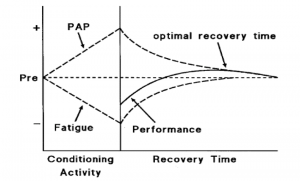English Assignment 1-3
Criteria:
Assignment 1-3 is an exercise that practices the ability to define a relatively complex professional jargon in a manner that consumers unfamiliar in the field may understand. The term is defined in 3 methods; a parenetical definition, a sentence definition, and an expanded definition.
Term:
Post-activation potentiation
Situation:
A personal trainer explaining the term ‘post-activation potentiation’ to a high jump athlete.
Parenetical definition:
Implementation of post-activation potentiation (the increased muscle performance that occurs after recent exercise) in resistance training allows for the maximization of muscle stimulation.
Sentence Definition:
Post-activation potentiation is a concept that increases muscle performance caused by recent near-maximal to maximal force contractions.
Expanded Definition:
Post-activation potentiation (PAP) is a concept that allows for an increase in the amount of force generated during muscle performance following utilization of the muscle to a near-maximal to maximal point. Muscles under the effects of PAP generate force quicker, as well as reach maximal force faster (Tillin & Bishop, 2009).
These changes in performance are beneficial to explosive type movements and can be applied to prior to various athletic competitions. Athletes that may benefit from PAP may include high jump athletes, powerlifters, plyometrics, and sprinters (Lowery, et al., 2012). It has been suggested that it may also provide benefits in training muscular power; however, studies are inconclusive of the results (Tillin & Bishop, 2009).
To produce an enhanced performance, PAP generally consists of 3 general stages – the initial muscle contraction, a recovery period, and the subsequent enhanced muscle contraction (Tillin & Bishop, 2009). The initial near-maximal to maximal contraction creates potentiation force and fatigue (Tillin & Bishop, 2009). Immediately after the initial contraction is when potentiation force is the greatest, but so is fatigue, which has a debilitating effect on muscle performance (Tillin & Bishop, 2009). Following the initial contraction is a recovery period. During the recovery period, both potentiation force and fatigue recede; However, enhanced muscle performance (PAP) is able to occur as the rate of recovery from fatigue is faster than the rate of potentiation dissipation (Lowery, et al., 2012). The optimal recovery duration depends on the individual. Results from a study done by Golaś et al., suggest that that 6 minutes of recovery was optimal for 58% of their sample, with the longest optimal recovery period at 8 minutes. Other studies in literature suggest that optimal recovery times may require as long as 16 minutes (do Carmo, et al., 2018). The subsequent contraction for heightened performance occurs during this window, when potentiation force is greater than effects of fatigue.
Figure 1
Relationship between PAP and Fatigue

Figure 1 illustrates the relationship in muscle performance between potentiation force generated by PAP and fatigue. After a near-maximal to maximal contraction (condition volume), the potentiation force and fatigue are greatest. Fatigue recovers faster than the dissipation of potentiation force which allows for increased performance (window 2). Reprinted from “Postactivation potentiation: role in human performance”, by Sale, D., 2002, Exercise Sports Science Reviews, 30(3), p. 142
The mechanisms that cause PAP are inconclusive; however, there are three main theories that attempt to explain it. The first is that due to the previous muscle contraction, the muscle fibers are more sensitive to the catalysts that cause muscle contractions, allowing for quicker subsequent contractions (Gołaś, et al., 2016). The second is that there is an increase in the recruitment of higher order motor units, which are generally responsible for faster, explosive movements (Gołaś, et al., 2016). The last main theory is that due to the initial contraction, the muscle fibres are then angled in a manner that is more optimal for force production (Tillin & Bishop, 2009).
References
do Carmo, E. C., De Souza, E. O., Roschel, H., Kobal, R., Ramos, H., Gil, S., & Tricoli, V. (2018). Self-Selected Rest Interval Improves Vertical Jump Post-Activation Potentiation. Journal of Strength and Conditioning Research, 33(10), 1 – 20. doi:10.1519/JSC.0000000000002519
Gołaś, A., Maszczyk, A., Zajac, A., Mikołajec, K., & Stastny, P. (2016). Optimizing post activation potentiation for explosive activities in competitive sports. Journal of Human Kinetics, 52, 95 – 106. doi:10.1515/hukin-2015-0197
Lowery, R. P., Duncan, N. M., Loenneke, J. P., Sikorski, E. M., Naimo, M. A., Brown, L. E., . . . Wilson, J. M. (2012). The effects of potentiating stimuli intensity under varying rest periods on vertical jump performance and power. Journal of Strength and Conditioning Research, 26(12), 3320 – 3325. doi:10.1519/JSC.0b013e318270fc56
Sale, D. (2002). Postactivation potentiation: role in human performance. Exercise and Sport Sciences Reviews, 30(3), 139 – 143. doi:10.1097/00003677-200207000-00008
Tillin, N. A., & Bishop, D. (2009). Factors Modulating Post-Activation Potentiation and its Effect on Performance of Subsequent Explosive Activities. Sports Medicine, 39(2), 147 – 166. doi:10.2165/00007256-200939020-00004
Leave a Reply